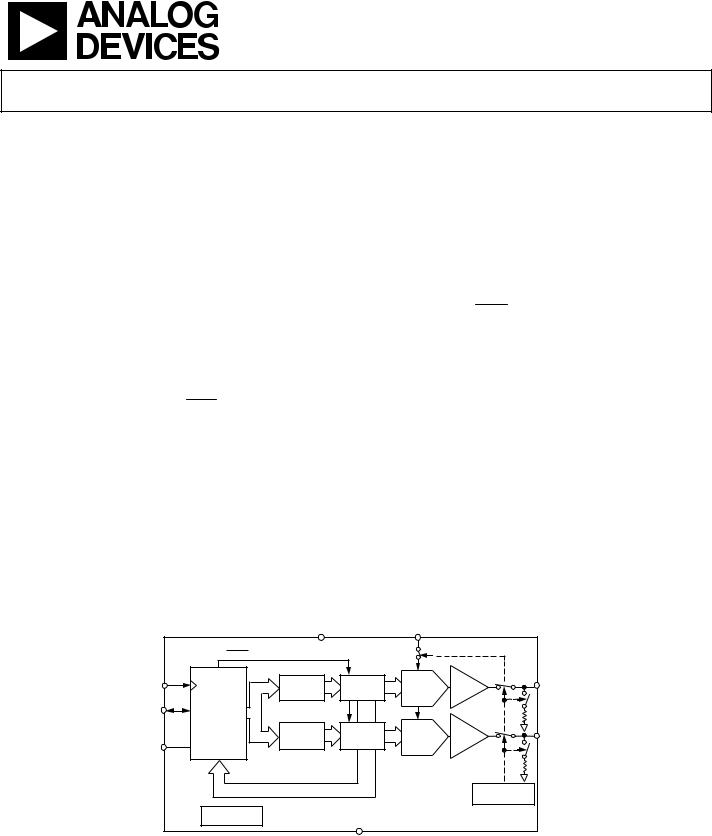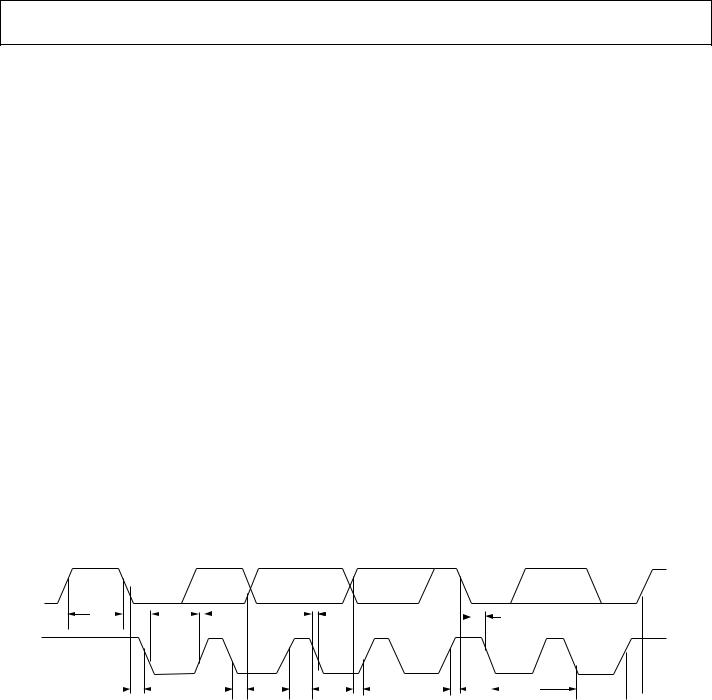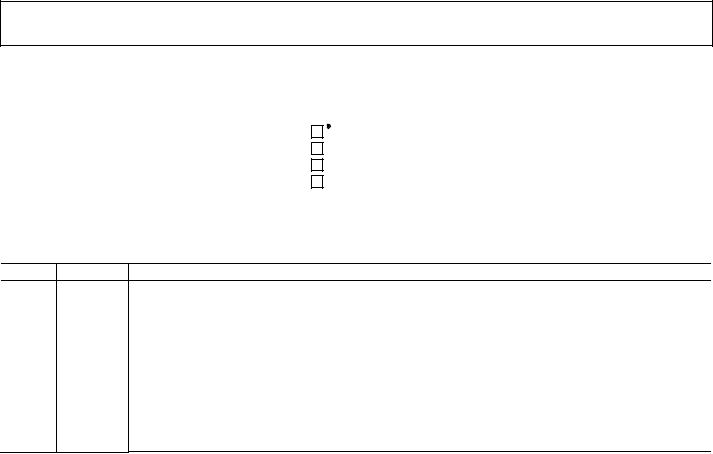ANALOG DEVICES AD5337, AD5338, AD5339 Service Manual

AD5337
2.5 V to 5.5 V, 250 µA, 2-Wire Interface Dual-Voltage Output, 8-/10-/12-Bit DACs
AD5337/AD5338/AD5339
FEATURES
AD5337
2buffered 8-bit DACs in 8-lead MSOP AD5338, AD5338-1
2buffered 10-bit DACs in 8-lead MSOP AD5339
2buffered 12-bit DACs in 8-lead MSOP
Low power operation: 250 mA @ 3 V, 300 mA @ 5 V 2-wire (I2C®compatible) serial interface
2.5 V to 5.5 V power supply
Guaranteed monotonic by design over all codes Power-down to 80 nA @ 3 V, 200 nA @ 5 V
3 power-down modes Double-buffered input logic Output range: 0 V to VREF Power-on reset to 0 V
Simultaneous update of outputs (LDAC function) Software clear facility
Data readback facility
On-chip rail-to-rail output buffer amplifiers Temperature range −40°C to +105°C
GENERAL DESCRIPTION
AD5337/AD5338/AD5339 are dual 8-, 10-, and 12-bit buffered voltage output DACs in an 8-lead MSOP package, which operate from a single 2.5 V to 5.5 V supply, consuming 250 µA at 3 V. On-chip output amplifiers allow rail-to-rail output swing with a slew rate of 0.7 V/µs. A 2-wire serial interface operates at clock rates up to 400 kHz. This interface is SMBus-compatible at VDD < 3.6 V. Multiple devices can be placed on the same bus.
The references for the two DACs are derived from one reference pin. The outputs of all DACs may be updated simultaneously using the software LDAC function. The parts incorporate a power-on reset circuit that ensures that the DAC outputs power up to 0 V and remain there until a valid write to the device takes place. A software clear function resets all input and DAC registers to 0 V. A power-down feature reduces the current consumption of the devices to 200 nA @ 5 V (80 nA @ 3 V).
The low power consumption of these parts in normal operation makes them ideally suited to portable battery-operated equipment. The power consumption is typically 1.5 mW at 5 V and 0.75 mW at 3 V, reducing to 1 µW in power-down mode.
APPLICATIONS
Portable battery-powered instruments
Digital gain and offset adjustment
Programmable voltage and current sources
Programmable attenuators
Industrial process control
FUNCTIONAL BLOCK DIAGRAM
|
|
VDD |
|
REFIN |
|
|
|
LDAC |
|
|
|
|
|
SCL |
|
INPUT |
DAC |
STRING |
BUFFER |
VOUTA |
|
REGISTER |
REGISTER |
DAC A |
|||
|
INTERFACE |
|
|
|||
SDA |
|
|
|
|
|
|
LOGIC |
|
|
|
|
|
|
|
|
INPUT |
DAC |
STRING |
BUFFER |
VOUTB |
A0 |
|
REGISTER |
REGISTER |
DAC B |
||
|
|
|
|
|
|
|
|
|
|
|
|
POWER-DOWN |
|
|
|
|
|
|
LOGIC |
|
|
POWER-ON |
AD5337/AD5338/AD5339 |
|
03756-A-001 |
||
|
RESET |
|
|
|
|
|
|
|
|
GND |
|
|
|
|
|
|
|
|
|
|
Figure 1.
Rev. A
Information furnished by Analog Devices is believed to be accurate and reliable. However, no responsibility is assumed by Analog Devices for its use, nor for any infringements of patents or other rights of third parties that may result from its use. Specifications subject to change without notice. No license is granted by implication or otherwise under any patent or patent rights of Analog Devices. Trademarks and registered trademarks are the property of their respective owners.
One Technology Way, P.O. Box 9106, Norwood, MA 02062-9106, U.S.A. Tel: 781.329.4700 www.analog.com Fax: 781.326.8703 © 2004 Analog Devices, Inc. All rights reserved.

AD5337/AD5338/AD5339
TABLE OF CONTENTS |
|
Specifications..................................................................................... |
3 |
AC Characteristics........................................................................ |
5 |
Timing Characteristics ................................................................ |
6 |
Absolute Maximum Ratings............................................................ |
7 |
ESD Caution.................................................................................. |
7 |
Pin Configuration and Function Descriptions............................. |
8 |
Terminology ...................................................................................... |
9 |
Typical Performance Characteristics ........................................... |
11 |
Functional Description .................................................................. |
15 |
Digital-to-Analog Converter Section ...................................... |
15 |
Resistor String............................................................................. |
15 |
DAC Reference Inputs ............................................................... |
15 |
Output Amplifier........................................................................ |
15 |
Power-on Reset ........................................................................... |
15 |
REVISION HISTORY |
|
10/04—Changed Data Sheet from Rev. 0 to Rev. A |
|
Updated Format.................................................................. |
Universal |
Added AD5338-1................................................................ |
Universal |
Changes to Specifications ................................................................ |
4 |
Updated Outline Dimensions ....................................................... |
24 |
Changes to Ordering Guide .......................................................... |
24 |
11/03—Rev. 0: Initial Version |
|
Serial Interface ............................................................................ |
15 |
Write Operation.......................................................................... |
17 |
Read Operation........................................................................... |
18 |
Double-Buffered Interface ........................................................ |
19 |
Power-Down Modes .................................................................. |
19 |
Applications..................................................................................... |
20 |
Typical Application Circuit....................................................... |
20 |
Bipolar Operation....................................................................... |
20 |
Multiple Devices on One Bus ................................................... |
20 |
Product as a Digitally Programmable Window Detector ..... |
21 |
Coarse and Fine Adjustment Capabilities............................... |
21 |
Power Supply Decoupling ......................................................... |
21 |
Outline Dimensions ....................................................................... |
24 |
Ordering Guide .......................................................................... |
24 |
Rev. A | Page 2 of 24

AD5337/AD5338/AD5339
SPECIFICATIONS
VDD = 2.5 V to 5.5 V; VREF = 2 V; RL = 2 kΩ to GND; CL = 200 pF to GND; all specifications TMIN to TMAX, unless otherwise noted.
Table 1.
|
|
Grade A |
|
|
Grade B |
|
|
|
Parameter1 |
Min |
Typ |
Max |
Min |
Typ |
Max |
Unit |
B Version2 Conditions/Comments |
DC PERFORMANCE3, 4 |
|
|
|
|
|
|
|
|
AD5337 |
|
|
|
|
|
|
|
|
Resolution |
|
8 |
|
|
8 |
|
Bits |
|
Relative Accuracy |
|
±0.15 |
±1 |
|
±0.15 |
±0.5 |
LSB |
|
|
|
|
|
|
|
|
|
Guaranteed monotonic by design over |
Differential Nonlinearity |
|
±0.02 |
±0.25 |
|
±0.02 |
±0.25 |
LSB |
all codes |
AD5338 |
|
|
|
|
|
|
|
|
Resolution |
|
10 |
|
|
10 |
|
Bits |
|
Relative Accuracy |
|
±0.5 |
±4 |
|
±0.5 |
±2 |
LSB |
|
|
|
|
|
|
|
|
|
Guaranteed monotonic by design over |
Differential Nonlinearity |
|
±0.05 |
±0.5 |
|
±0.05 |
±0.50 |
LSB |
all codes |
AD5339 |
|
|
|
|
|
|
|
|
Resolution |
|
12 |
|
|
12 |
|
Bits |
|
Relative Accuracy |
|
±2 |
±16 |
|
±2 |
±8 |
LSB |
|
|
|
|
|
|
|
|
|
Guaranteed monotonic by design over |
Differential Nonlinearity |
|
±0.2 |
±1 |
|
±0.2 |
±1 |
LSB |
all codes |
Offset Error |
|
±0.4 |
±3 |
|
±0.4 |
±3 |
% of FSR |
|
Gain Error |
|
±0.15 |
±1 |
|
±0.15 |
±1 |
% of FSR |
|
|
|
|
|
|
|
|
|
Lower deadband exists only if offset error |
Lower Deadband |
|
20 |
60 |
|
20 |
60 |
mV |
is negative |
Offset Error Drift5 |
|
|
|
|
|
|
ppm of |
|
|
−12 |
|
|
−12 |
|
FSR/°C |
|
|
Gain Error Drift5 |
|
|
|
|
|
|
ppm of |
|
|
−5 |
|
|
−5 |
|
FSR/°C |
|
|
Power Supply Rejection |
|
|
|
|
|
|
|
|
Ratio5 |
|
−60 |
|
|
−60 |
|
dB |
∆VDD = ±10% |
DC Crosstalk5 |
|
200 |
|
|
200 |
|
µV |
RL = 2 kΩ to GND or VDD |
DAC REFERENCE INPUTS5 |
|
|
|
|
|
|
|
|
VREF Input Range |
0.25 |
|
VDD |
0.25 |
|
VDD |
V |
|
VREF Input Impedance |
37 |
45 |
|
37 |
45 |
|
kΩ |
Normal operation |
|
|
>10 |
|
|
>10 |
|
MΩ |
Power-down mode |
Reference Feedthrough |
|
−90 |
|
|
−90 |
|
dB |
Frequency = 10 kHz |
|
|
|
|
|
|
|
|
|
OUTPUT CHARACTERISTICS5 |
|
|
|
|
|
|
|
|
|
|
|
|
|
|
|
|
This is a measure of the minimum and |
Minimum Output Voltage6 |
|
|
|
|
|
|
|
maximum drive capabilities of the output |
|
0.001 |
|
|
0.001 |
|
V |
amplifier. |
|
Maximum Output |
|
VDD − |
|
|
VDD − |
|
|
|
Voltage6 |
|
0.001 |
|
|
0.001 |
|
V |
|
DC Output Impedance |
|
0.5 |
|
|
0.5 |
|
Ω |
|
Short Circuit Current |
|
25 |
|
|
25 |
|
mA |
VDD = 5 V |
|
|
16 |
|
|
16 |
|
mA |
VDD = 3 V |
|
|
|
|
|
|
|
|
Coming out of power-down mode. |
Power-Up Time |
|
2.5 |
|
|
2.5 |
|
µs |
VDD = 5 V |
|
|
|
|
|
|
|
|
Coming out of power-down mode. |
|
|
5 |
|
|
5 |
|
µs |
VDD = 3 V |
Rev. A | Page 3 of 24

AD5337/AD5338/AD5339
|
|
|
|
Grade A |
|
|
Grade B |
|
|
|
|
Parameter1 |
Min |
Typ |
Max |
Min |
Typ |
Max |
Unit |
B Version2 Conditions/Comments |
|
|
LOGIC INPUTS (A0)5 |
|
|
|
|
|
|
|
|
|
|
Input Current |
|
|
|
±1 |
|
|
±1 |
µA |
|
|
VIL, Input Low Voltage |
|
|
|
0.8 |
|
|
0.8 |
V |
VDD = 5 V ±10% |
|
|
|
|
|
0.6 |
|
|
0.6 |
V |
VDD = 3 V ±10% |
|
|
|
|
|
0.5 |
|
|
0.5 |
V |
VDD = 2.5 V |
|
VIH, Input High Voltage |
2.4 |
|
|
|
2.4 |
|
|
V |
VDD = 5 V ±10% |
|
|
2.1 |
|
|
|
2.1 |
|
|
V |
VDD = 3 V ±10% |
|
|
2.0 |
|
|
|
2.0 |
|
|
V |
VDD = 2.5 V |
|
Pin Capacitance |
|
3 |
|
|
3 |
|
pF |
|
|
|
LOGIC INPUTS (SCL, SDA)5 |
|
|
|
|
|
|
|
|
|
|
VIH, Input High Voltage |
0.7 |
|
|
VDD + |
0.7 |
|
VDD + |
V |
SMBus-compatible at VDD < 3.6 V |
|
|
VDD |
|
|
0.3 |
VDD |
|
0.3 |
|
|
|
VIL, Input Low Voltage |
−0.3 |
|
|
+0.3 |
–0.3 |
|
+0.3 |
V |
SMBus-compatible at VDD < 3.6 V |
|
|
|
|
|
VDD |
|
|
VDD |
|
|
|
IIN, Input Leakage Current |
|
|
|
±1 |
|
|
±1 |
µA |
|
|
VHYST, Input Hysteresis |
0.05 |
|
|
|
0.05 |
|
|
V |
|
|
|
VDD |
|
|
|
VDD |
|
|
|
|
|
CIN, Input Capacitance |
|
8 |
|
|
8 |
|
pF |
|
|
|
Glitch Rejection |
|
|
|
50 |
|
|
50 |
ns |
Input filtering suppresses noise spikes of |
|
|
|
|
|
|
|
|
|
|
less than 50 ns |
|
LOGIC OUTPUT (SDA)5 |
|
|
|
|
|
|
|
|
|
|
VOL, Output Low Voltage |
|
|
|
0.4 |
|
|
0.4 |
V |
ISINK = 3 mA |
|
|
|
|
|
0.6 |
|
|
0.6 |
V |
ISINK = 6 mA |
|
Three-State Leakage |
|
|
|
±1 |
|
|
±1 |
µA |
|
|
Current |
|
|
|
|
|
|
|
|
|
|
Three-State Output |
|
8 |
|
|
8 |
|
pF |
|
|
|
Capacitance |
|
|
|
|
|
|
|
|
|
|
|
|
|
|
|
|
|
|
|
|
|
POWER REQUIREMENTS |
|
|
|
|
|
|
|
|
|
|
VDD |
2.5 |
|
|
5.5 |
2.5 |
|
5.5 |
V |
|
|
IDD (Normal Mode)7 |
|
|
|
|
|
|
|
|
VIH = VDD and VIL = GND |
|
VDD = 4.5 V to 5.5 V |
|
300 |
375 |
|
300 |
375 |
µA |
|
|
|
VDD = 2.5 V to 3.6 V |
|
250 |
350 |
|
250 |
350 |
µA |
|
|
|
IDD (Power-Down Mode) |
|
|
|
|
|
|
|
|
VIH = VDD and VIL = GND |
|
VDD = 4.5 V to 5.5 V |
|
0.2 |
1.0 |
|
0.2 |
1.0 |
µA |
IDD = 4 µA (max) during 0 readback |
|
|
|
|
|
|
|
|
|
|
|
on SDA |
|
VDD = 2.5 V to 3.6 V |
|
0.08 |
1.00 |
|
0.08 |
1.00 |
µA |
IDD = 1.5 µA (max) during 0 readback |
|
|
|
|
|
|
|
|
|
|
|
on SDA |
|
|
|
|
|
|
|
|
|
|
|
|
|
|
|
|
|
|
|
|
|
|
1 For explanations of the specific parameters, see the Terminology section. 2 Temperature range: (A and B versions): −40°C to +105°C; typical at 25°C. 3 DC specifications tested with the outputs unloaded.
4 Linearity is tested using a reduced code range: AD5337 (Codes 8 to 248); AD5338, AD5338-1 (Codes 28 to 995); AD5339 (Codes 115 to 3981). 5 Guaranteed by design and characterization; not production tested.
6 For the amplifier output to reach its minimum voltage, offset error must be negative; to reach its maximum voltage, VREF = VDD and offset plus gain error must be positive.
7 IDD specification is valid for all DAC codes. Interface inactive. All DACs active and excluding load currents.
Rev. A | Page 4 of 24

AD5337/AD5338/AD5339
AC CHARACTERISTICS1
VDD = 2.5 V to 5.5 V; RL = 2 kΩ to GND; CL = 200 pF to GND; all specifications TMIN to TMAX, unless otherwise noted.
Table 2.
|
|
|
A and B Versions2 |
|
|
||
|
Parameter3 |
Min |
Typ |
Max |
Unit |
Conditions/Comments |
|
|
Output Voltage Settling Time |
|
|
|
|
VREF = VDD = 5 V |
|
|
AD5337 |
|
6 |
8 |
µs |
1/4 scale to 3/4 scale change (0x40 to 0xC0) |
|
|
AD5338 |
|
7 |
9 |
µs |
1/4 scale to 3/4 scale change (0x100 to 0x300) |
|
|
AD5339 |
|
8 |
10 |
µs |
1/4 scale to 3/4 scale change (0x400 to 0xC00) |
|
|
Slew Rate |
|
0.7 |
|
V/µs |
|
|
|
Major-Code Transition Glitch Energy |
|
12 |
|
nV-s |
1 LSB change around major carry |
|
|
Digital Feedthrough |
|
1 |
|
nV-s |
|
|
|
Digital Crosstalk |
|
1 |
|
nV-s |
|
|
|
DAC-to-DAC Crosstalk |
|
3 |
|
nV-s |
|
|
|
Multiplying Bandwidth |
|
200 |
|
kHz |
VREF = 2 V ± 0.1 V p-p |
|
|
Total Harmonic Distortion |
|
−70 |
|
dB |
VREF = 2.5 V ± 0.1 V p-p. Frequency = 10 kHz |
|
|
|
|
|
|
|
|
|
|
|
|
|
|
|
|
|
1 Guaranteed by design and characterization; not production tested.
2 Temperature range: A and B versions: −40°C to +105°C; typical at 25°C.
3 For explanations of the specific parameters, see the Terminology section.
Rev. A | Page 5 of 24

AD5337/AD5338/AD5339
TIMING CHARACTERISTICS
VDD = 2.5 V to 5.5 V. All specifications TMIN to TMAX, unless otherwise noted.
Table 3.
|
|
Limit at TMIN, TMAX |
|
|
|
|
Parameter |
(A and B Versions) |
Unit |
Conditions/Comments |
|
|
|
|
|
|
|
|
fSCL |
400 |
|
kHz max |
SCL clock frequency |
|
t1 |
2.5 |
|
µs min |
SCL cycle time |
|
t2 |
0.6 |
|
µs min |
tHIGH, SCL high time |
|
t3 |
1.3 |
|
µs min |
tLOW, SCL low time |
|
t4 |
0.6 |
|
µs min |
tHD, STA, start/repeated start condition hold time |
|
t5 |
100 |
|
ns min |
tSU, DAT, data setup time |
|
t61 |
0.9 |
|
µs max |
tHD, DAT, data hold time |
|
|
0 |
|
µs min |
tHD, DAT, data hold time |
|
t7 |
0.6 |
|
µs min |
tSU, STA, setup time for repeated start |
|
t8 |
0.6 |
|
µs min |
tSU, STO, stop condition setup time |
|
t9 |
1.3 |
|
µs min |
tBUF, bus free time between a stop and a start condition |
|
t10 |
300 |
|
ns max |
tR, rise time of SCL and SDA when receiving |
|
|
0 |
|
ns min |
tR, rise time of SCL and SDA when receiving (CMOS-compatible) |
|
t11 |
250 |
|
ns max |
tF, fall time of SDA when transmitting |
|
|
0 |
|
ns min |
tF, fall time of SDA when receiving (CMOS-compatible) |
|
|
300 |
|
ns max |
tF, fall time of SCL and SDA when receiving |
|
|
20 + 0.1 CB2 |
ns min |
tF, fall time of SCL and SDA when transmitting |
|
|
CB |
400 |
|
pF max |
Capacitive load for each bus line |
|
|
|
|
|
|
|
|
|
|
|
|
1A master device must provide a hold time of at least 300 ns for the SDA signal (referred to VIH min of the SCL signal) in order to bridge the undefined region of SCL’s falling edge.
2 CB is the total capacitance of one bus line in pF; tR and tF measured between 0.3 VDD and 0.7 VDD.
SDA
|
|
|
|
|
|
|
|
|
|
|
|
|
|
|
|
|
|
|
|
|
t9 |
|
|
||||||||||||||||||
|
|
|
t3 |
|
|
|
|
t10 |
|
|
|
t11 |
|
|
t4 |
|||||
|
|
|
|
|
|
|
|
|
|
|
|
|
|
|
|
|
|
|
|
|
SCL
|
|
|
|
|
|
|
|
|
|
|
|
|
|
|
|
|
|
|
|
|
|
|
|
|
|
|
|
|
|
|
|
|
|
|
t4 |
|
|
|
|
|
|
|
|
|
|
|
|
|
|
|
|
|
|
|
|
|
|
|
|
|
|
|
|
|
|
|
|
|
|
|
|
|
|
|
|
|
|
|
t2 |
|
|
|
|
|
|
|
|
|
|
|
|
|
|
|
|
|||
|
|
|
|
|
|
|
t6 |
|
|
|
|
|
|
|
|
|
|
|
|
|
|
|
|
|
|
|
t1 |
|||||
|
|
|
|
|
|
|
|
|
|
|
|
|
|
|
|
|||||||||||||||||
|
|
|
|
|
|
|
|
|
|
|
|
|
|
|
|
|
|
|
|
|
|
|
|
|
||||||||
START |
|
|
|
|
|
|
|
|
|
|
|
|
|
|
t5 |
|
|
|
|
|
t7 |
|
|
|
|
|||||||
|
|
|
|
|
|
|
|
|
|
|
|
|
|
|
|
|
|
|
||||||||||||||
|
|
|
|
|
|
|
|
|
|
|
|
|
|
|
|
|
REPEATED |
|||||||||||||||
CONDITION |
|
|
|
|
|
|
|
|
|
|
|
|
|
|
|
|
|
|||||||||||||||
|
|
|
|
|
|
|
|
|
|
|
|
|
|
|
|
|
|
|
|
|
|
|
|
START |
||||||||
CONDITION
 t8
t8 
STOP
CONDITION
03756-A-002
Figure 2. 2-Wire Serial Interface Timing Diagram
Rev. A | Page 6 of 24

AD5337/AD5338/AD5339
ABSOLUTE MAXIMUM RATINGS
TA = 25°C, unless otherwise noted.
Table 4.
Parameter |
Rating |
|
|
VDD to GND |
−0.3 V to +7 V |
SCL, SDA to GND |
−0.3 V to VDD + 0.3 V |
A0 to GND |
−0.3 V to VDD + 0.3 V |
Reference Input Voltage to GND |
−0.3 V to VDD + 0.3 V |
VOUTA−VOUTB to GND |
−0.3 V to VDD + 0.3 V |
Operating Temperature Range |
|
Industrial (B Version) |
−40°C to +105°C |
Storage Temperature Range |
−65°C to +150°C |
Junction Temperature (TJ max) |
150°C |
MSOP Package |
|
Power Dissipation |
(TJ max − TA)θJA |
θJA Thermal Impedance |
206°C/W |
θJC Thermal Impedance |
44°C/W |
Reflow Soldering |
|
Peak Temperature |
220 +5/−0°C |
Time at Peak Temperature |
10 s to 40 s |
|
|
Stresses above those listed under Absolute Maximum Ratings may cause permanent damage to the device. This is a stress rating only, and functional operation of the device at these or any other conditions above those indicated in the operational section of this specification is not implied. Exposure to absolute maximum rating conditions for extended periods may affect device reliability.
Transient currents of up to 100 mA do not cause SCR latch-up.
ESD CAUTION
ESD (electrostatic discharge) sensitive device. Electrostatic charges as high as 4000 V readily accumulate on the human body and test equipment and can discharge without detection. Although this product features proprietary ESD protection circuitry, permanent damage may occur on devices subjected to high energy electrostatic discharges. Therefore, proper ESD precautions are recommended to avoid performance degradation or loss of functionality.
Rev. A | Page 7 of 24

AD5337/AD5338/AD5339
PIN CONFIGURATION AND FUNCTION DESCRIPTIONS
VDD |
1 |
|
|
A0 |
|
AD5337/ |
8 |
||||
V A |
2 |
AD5338/ |
|
SCL |
|
7 |
|||||
OUT |
|
AD5339 |
|||
VOUTB |
3 |
|
SDA |
||
TOP VIEW |
6 |
||||
REFIN |
4 |
(Not to Scale) |
|
GND |
|
5 |
|||||
|
|
|
|
|
Figure 3. Pin Configuration
03756-A-003
Table 5. Pin Function Descriptions
Pin No. Mnemonic
1VDD
2VOUTA
3VOUTB
4REFIN
5GND
6SDA
7SCL
8A0
Function
Power Supply Input. These parts can be operated from 2.5 V to 5.5 V, and the supply should be decoupled to GND. Buffered Analog Output Voltage from DAC A. The output amplifier has rail-to-rail operation.
Buffered Analog Output Voltage from DAC B. The output amplifier has rail-to-rail operation. Reference Input Pin for the Two DACs. It has an input range from 0.25 V to VDD.
Ground Reference Point for All Circuitry on the Parts.
Serial Data Line. This is used in conjunction with the SCL line to clock data into or out of the 16-bit input shift register. It is a bidirectional open-drain data line that should be pulled to the supply with an external pull-up resistor.
Serial Clock Line. This is used in conjunction with the SDA line to clock data into or out of the 16-bit input shift register. Clock rates of up to 400 kbps can be accommodated in the 2-wire interface.
Address Input. Sets the least significant bit of the 7-bit slave address.
Rev. A | Page 8 of 24
